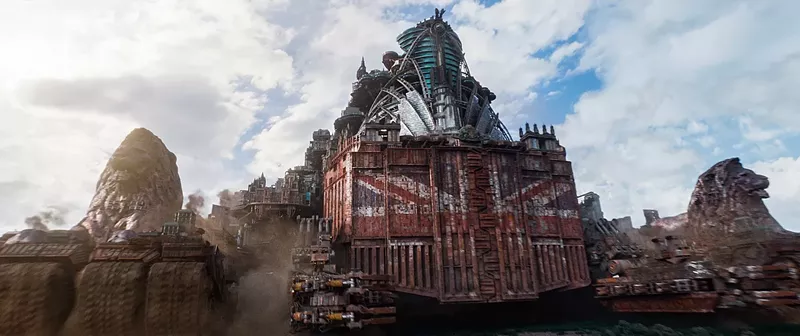Look, even Peter Jackson’s worst movies offer moments of bonkers grandeur, as he chucks his orcs and dwarves and dragons against each other on a scale that’s three parts kid-in-a-sandbox to one part Sergei Eisenstein. Christian Rivers’ adaptation of Philip Reeve’s apocalyptic YA novel Mortal Engines isn’t directed by Jackson, the man behind The Lord of the Rings, The Hobbit and 2005’s King Kong. But Jackson produced, co-wrote the script with his regular partners Fran Walsh and Philippa Boyens and, like most other movies from Jackson’s company, WingNut Films, its scope is hilariously, unreasonably huge. The first twenty minutes are the best and stand as a perfect illustration of the logic behind buying subscription passes to your local multiplex: By all means, go watch the opening on the biggest screen possible if you have any interest in beholding a chase scene between great cities built atop colossal tank-treaded vehicles. Then maybe go about your day.
Yes, there are mobile cities eating each other: The sequence finds horizon-wide London, its skyline as jumbled up with landmarks as the roof of Las Vegas’s New York New York casino, stalking a much smaller Balkan town across the steppes. The camera swoops around the impossible combatants, showing us complex action with clarity and verve. Imagine the white city from the third Lord of the Rings movie gone steampunk and roving the landscape like an angry Pac-Man: This stuff is wonderfully weird and expertly rendered.
But shouldn’t the sight of London rolling across Europe to eat the less powerful resonate more than this? That sequence is a marvel, but it would be better if we had any reason to care about anyone in it, and it would be better still if it kicked off a movie that equaled its wonder with character and theme. Or anything, really. What follows that spectacular start is a confused, clanging film too rushed to invest emotion into. It answers a complaint that many viewers had about Jackson’s second and third Hobbit movies, but does so the wrong way: Rather than three hours of aimless action and little story, Mortal Engines runs just over two — but the proportions of action to story are still out of whack. The film plays as if a three-hour epic has been sliced down to size in the editing, but only the scenes establishing character and context have been cut.
By the end, that’s no great loss, as the film’s climax is sketched over a Star Wars outline. Scrappy rebel pilots race to stop a mega-weapon from destroying all that’s good in the world. The hero, a young assassin (Hera Hilmar) who hides her face behind a scarlet hankie confronts the big villain (Hugo Weaving), who in this case just can’t quite bring himself to speak to her the most famous line in Star Wars history. (Or the second-most famous, behind “May the Force be with you.”) Weaving’s character is operating by The Price Is Right rules with the film’s twist revelation about the relationship between villain and hero — he comes as close as possible to saying it without going over. And Weaving, the trouper, at least makes all the boilerplate bad-guy speeches fun, tearing into them with all the eager zest of my cat tearing into that chicken breast it once yanked off my counter.
The shame of it is that there are promising ideas here, beyond the suggestive notion of a law-of-the-jungle future in which the wealthiest city-state gobbles up the poorest as literal fuel. Our scarred and furious hero is out to murder her adversary, and she gets a knife into him in the first moments we know her. Such out-of-the-gate aggression is newish for a young female lead in a YA movie, though the film soon commits itself to housebreaking her and — inevitably — forcing her to fall in love with a hunky dipstick. She has persuasive reasons for wanting to kill Weaving’s character, a treacherous London muckety-muck named Thaddeus Valentine. But they’re much less interesting than the fact that she’s pursued in her quest by the indefatigable undead warrior Shrike (Stephen Lang), a slow-mo death machine whose release from a rusted-cube jail cell makes for the film’s other first-rate fantasy-action sequence. Shrike has no clear analog in previous movies or familiar adventure tales: He raised our hero and wants to kill her to make her more like him; he has no heart but is motivated by a perverse sort of love. At least that’s what I think his deal is. This adaptation lurches too abruptly from set piece to set piece to make the basics clear, and between the occasional bursts of wonder, I found the film too dark and uninviting to command my full attention. In short, my mind wandered.
To their credit, the filmmakers highlight, in their finale, the moral murk of blowing up Death Stars — what about all the people who just work there? But elsewhere, this Mortal Engines tends to forget the regular people. Hunting his mentee, Shrike destroys a city held aloft by gasbags, killing thousands, but neither our hero nor her new pilot pals takes even a second to mourn the loss — or to ask whether she’s at all culpable. After all, if she had settled her issues with Shrike before setting out on her own murder-quest, those people might still be alive. Worse, the filmmakers include, in this film rated PG-13, a quick scene of gunmen bursting in and mowing down an office full of everyday folks working in a rolling city’s command center. It’s entirely unnecessary to the story, just as a similar scene was in the recent family adventure film Skyscraper. Both sequences make mass slaughter look easy, even a little badass. This truth shouldn’t even need to be said in 2018: Stop putting this shit into kids’ brains.

Audio By Carbonatix
[
{
"name": "GPT - Billboard - Slot Inline - Content - Labeled - No Desktop",
"component": "23668565",
"insertPoint": "2",
"requiredCountToDisplay": "2"
},{
"name": "STN Player - Float - Mobile Only ",
"component": "23853568",
"insertPoint": "2",
"requiredCountToDisplay": "2"
},{
"name": "Editor Picks",
"component": "17242653",
"insertPoint": "4",
"requiredCountToDisplay": "1"
},{
"name": "Inline Links",
"component": "18838239",
"insertPoint": "8th",
"startingPoint": 8,
"requiredCountToDisplay": "7",
"maxInsertions": 25
},{
"name": "GPT - 2x Rectangles Desktop, Tower on Mobile - Labeled",
"component": "24956856",
"insertPoint": "8th",
"startingPoint": 8,
"requiredCountToDisplay": "7",
"maxInsertions": 25
},{
"name": "Inline Links",
"component": "18838239",
"insertPoint": "8th",
"startingPoint": 12,
"requiredCountToDisplay": "11",
"maxInsertions": 25
},{
"name": "GPT - Leaderboard to Tower - Slot Auto-select - Labeled",
"component": "17676724",
"insertPoint": "8th",
"startingPoint": 12,
"requiredCountToDisplay": "11",
"maxInsertions": 25
}
]








